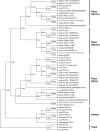Image-Based Analysis Revealing the Molecular Mechanism of Peroxisome Dynamics in Plants
- PMID: 35592252
- PMCID: PMC9110829
- DOI: 10.3389/fcell.2022.883491
Image-Based Analysis Revealing the Molecular Mechanism of Peroxisome Dynamics in Plants
Abstract
Peroxisomes are present in eukaryotic cells and have essential roles in various biological processes. Plant peroxisomes proliferate by de novo biosynthesis or division of pre-existing peroxisomes, degrade, or replace metabolic enzymes, in response to developmental stages, environmental changes, or external stimuli. Defects of peroxisome functions and biogenesis alter a variety of biological processes and cause aberrant plant growth. Traditionally, peroxisomal function-based screening has been employed to isolate Arabidopsis thaliana mutants that are defective in peroxisomal metabolism, such as lipid degradation and photorespiration. These analyses have revealed that the number, subcellular localization, and activity of peroxisomes are closely related to their efficient function, and the molecular mechanisms underlying peroxisome dynamics including organelle biogenesis, protein transport, and organelle interactions must be understood. Various approaches have been adopted to identify factors involved in peroxisome dynamics. With the development of imaging techniques and fluorescent proteins, peroxisome research has been accelerated. Image-based analyses provide intriguing results concerning the movement, morphology, and number of peroxisomes that were hard to obtain by other approaches. This review addresses image-based analysis of peroxisome dynamics in plants, especially A. thaliana and Marchantia polymorpha.
Keywords: Arabidopsis thaliana; Marchantia polymorpha; apem mutant; imaging; peroxisome; peup mutant.
Copyright © 2022 Goto-Yamada, Oikawa, Yamato, Kanai, Hikino, Nishimura and Mano.
Conflict of interest statement
The authors declare that the research was conducted in the absence of any commercial or financial relationships that could be construed as a potential conflict of interest.
Figures






Similar articles
-
Plant peroxisomes.Vitam Horm. 2005;72:111-54. doi: 10.1016/S0083-6729(05)72004-5. Vitam Horm. 2005. PMID: 16492470
-
Protein ubiquitination in plant peroxisomes.J Integr Plant Biol. 2023 Feb;65(2):371-380. doi: 10.1111/jipb.13346. Epub 2023 Jan 1. J Integr Plant Biol. 2023. PMID: 35975710 Review.
-
Novel proteins, putative membrane transporters, and an integrated metabolic network are revealed by quantitative proteomic analysis of Arabidopsis cell culture peroxisomes.Plant Physiol. 2008 Dec;148(4):1809-29. doi: 10.1104/pp.108.129999. Epub 2008 Oct 17. Plant Physiol. 2008. PMID: 18931141 Free PMC article.
-
A defect of peroxisomal membrane protein 38 causes enlargement of peroxisomes.Plant Cell Physiol. 2011 Dec;52(12):2157-72. doi: 10.1093/pcp/pcr147. Epub 2011 Oct 27. Plant Cell Physiol. 2011. PMID: 22034551
-
Peroxisome structure, function, and biogenesis--human patients and yeast mutants show strikingly similar defects in peroxisome biogenesis.J Neuropathol Exp Neurol. 1995 Sep;54(5):720-5. doi: 10.1097/00005072-199509000-00015. J Neuropathol Exp Neurol. 1995. PMID: 7666062 Review.
Cited by
-
Designing artificial synthetic promoters for accurate, smart, and versatile gene expression in plants.Plant Commun. 2023 Jul 10;4(4):100558. doi: 10.1016/j.xplc.2023.100558. Epub 2023 Feb 9. Plant Commun. 2023. PMID: 36760129 Free PMC article. Review.
-
Monitoring peroxisome dynamics using enhanced green fluorescent protein labeling in Alternaria alternata.Front Microbiol. 2022 Oct 25;13:1017352. doi: 10.3389/fmicb.2022.1017352. eCollection 2022. Front Microbiol. 2022. PMID: 36386634 Free PMC article.
References
Publication types
LinkOut - more resources
Full Text Sources

